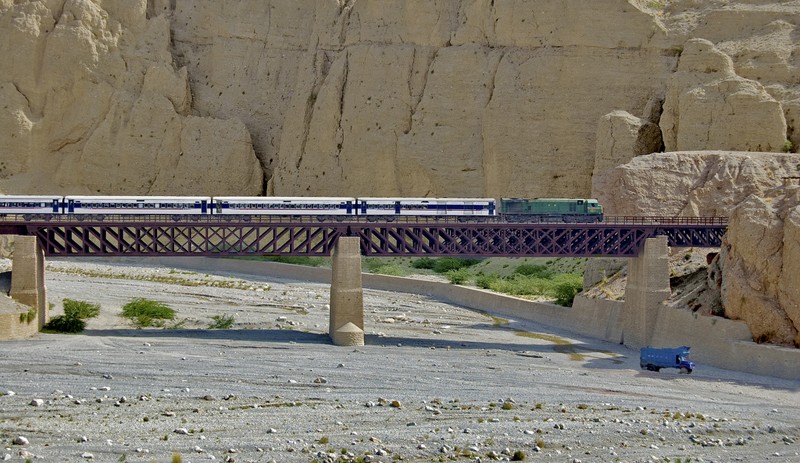
Unique sights and sounds mark the travel between Quetta and Lahore

I remember the exact date and time when I first left my home in Quetta for Lahore in pursuit of higher studies. The train left the station at 9am on February 8, 2011, and reached Lahore the next day at 5pm -- 8 hours behind schedule.
Ever since that first journey, I have had countless opportunities to travel by train. Even though it was the preferred mode of transport for my student friends and me, it was never a convenient experience.
It was only when the militants started attacking the railways with explosives that my family declared trains unsafe and allowed me to travel by air.
For commuters of the lower income class, mostly Punjabi settlers, labourers, soldiers, tableeghis (religious evangelists) and students, trains are a far safer and economical link between Punjab and Balochistan than buses that can be easily stopped by the militants. Also, they prefer trains because they come with mosques, restaurants and toilets. They are a veritable city on their own. In the economy class, travelling families hang shawls to protect themselves from stray gazes of passersby, effectively creating a private space of their own; students stack up their luggage for makeshift tables to play Ludo and cards; soldiers sleep throughout their journeys, and evangelists, experts in rail travel without tickets, adjust on other peoples’ seats.
Kazim, a lecturer at a university in Lahore, expresses gratitude to the British for leaving railway behind. Otherwise, "I wouldn’t have completed my college degree," he says. He would buy tickets in black from the coolies, and would hate travelling with evangelists, "for they held rigid ideas. But they offered me free food and knew how to talk, so they gained peoples’ trust," he adds.
For my friend Barkat, "Train journey gives you a perspective on life. You feel anguish and pain on leaving family and friends behind, where life is still and predictable, as you enter a chaotic and unknown territory."
Jaffer Express and Quetta Express are the two services that ply the Quetta-Lahore route, and only Jaffer Express continues on till Rawalpindi. Both trains are always fully booked.
The colonial era buildings of railway stations enroute portray a sound sense of materials in harmony. Where these structures fulfil their functional requirements, they vary in scale in different cities. The buildings are of vintage quality, yet they cater to the needs of today that haven’t changed according to Pakistan Railways standards.
As the train traverses a colourful terrain between Lahore and Quetta, different rock formations unfold. It chucks through the century-old, long, dark tunnels through the mountains of Bolan. Resting their weight on enormous vaults, these tunnels remind travellers of lives lost, of the local labourers who toiled for years on the orders of the British military engineers. The world can see proof of their perseverance on the tunnels’ entrance and exit where dates of completion are inscribed.
During a stopover at the small town of Aab-e-Gum, vendors selling wild dates gathered from the mountainsides board the train. They sell the fruit in elaborately woven pouches of date leaves. Here, passengers can sample the famous Akbar Khan’s tea, which he promotes with this amusing ditty:
Akbar Khan ki chai!
Bache ko jawan banae!
Jawan ko pehlwan banae!
Pehlwan ko maidaan
mein lai!
Akbar Khan ki chai!
Akbar Khan’s tea!
Makes a child a man!
Makes a man a
strongman!
Brings a strongman
out into the field!
Akbar Khan’s tea!
At Aab-e-Gum, the train leaves behind the mountains of North Balochistan for the harsh plains of Central Balochistan, which boast the fiercest climate in the country. A local of Sibi, the hottest city in Pakistan, tells me that these plains are cultivable only because the Musharraf government brought water to the area with canals.
The train enters Sindh at the Jacobabad junction. From here on, the terrain changes, and with it, the language too. Not tunnels but rivers divide the land and bridges connect the cities. The Lansdowne Bridge (1889), the longest ‘rigid’ girder bridge in the world in its time, and the Ayub Bridge (1962), the third longest arch suspension bridge of its day, were both built to connect the tracks over the river Indus at Sukkur-Rohri. People gather at the train doors and stick their heads out of windows to get a glimpse of these engineering marvels -- the structural integrity of which shames the likes of the recently-built cable decorated flyover at the Azadi Interchange in Lahore.
The journey through the plains of Sindh and Punjab are a foodie’s paradise. Vendors board the train at each station, selling all sorts of local fare and delicacies. At Jacobabad, vendors loudly peddle ripe mangoes, bananas and guavas like no other in the country. From the soil of Mehran Valley, Shikarpuris create pickles of exquisite sourness, famous all over the country, and which remain Shikarpur station’s call to fame. South Punjab treats travellers to the celebrated Khanpuri pairey, and Multani sohan halwa. When you hears the vendors’ calls for the equally famous Kasuri andrassa and falooda, you know Lahore is around the corner.
Despite getting coated with dust, grime and diesel smoke and suffering long delays and engine failures, people prefer to travel on trains -- because, Pakistan Railways, with its historic landmarks, picturesque journeys and economical fare, has developed a deep-rooted connection with the people of the land. A whole lot of low-ranking employees, vendors and common travellers depend on Pakistan Railways’ broken back for livelihood. Therefore, the Pakistan Railways must be recognised as a national heritage and steps must be taken to bring this institution back to its past glory.